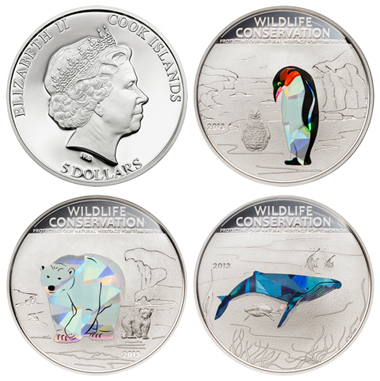June 6, 2013 – The Cook Islands offer us a small reminder that it is largely due to human interference that many species and habitats on earth are currently threatened. Each of these three silver coins designed by Coin Invest Trust depicts a female of a threatened species, illustrated in prism technique. For the first time in the history of the popular prism series, each coin not only has a different prism inlay, but also an individual coinage.
Cook Islands / 5 dollars / Silver 925 / 20 g / 38.61 mm / Mintage: 2,500 (each coin).
The obverse of the coins features a portrait of Queen Elizabeth II, the Cook Islands’ official head of state. The inscriptions include her name, Elizabeth II, the name of the issuing country, Cook Islands and the nominal value of the coin, 5 dollars.
The name of the series, Wildlife Conservation, appears in the upper, polished exergue of the reverse of the coins, as does the motto of the series, Protecting Our Natural Heritage For Tomorrow. The lower part of the reverse sides are matted and depict, in relief, both the respective animal’s habitat as well as a juvenile of the species – humpback whale, polar bear and penguin. The mother is illustrated in prism technique alongside the juvenile.
Since 1690 the Dodo is considered to be an extincted species. This is a reconstruction of the Reunion Island Dodo in the Natural History Museum, London. Photo: Drow male / http://creativecommons.org/licenses/by-sa/3.0/deed.en
Life on Earth has always been in a constant state of flux, and species either adapt or become extinct. It is in this delicate relationship that Charles Darwin discovered the evolutionary rule of natural selection. However, widespread human distribution across the entire planet and our intensive use and subjugation of the landscape and all its native animal and plant species have led to an unprecedented state. Human disturbance has led to the extinction of numerous animal species and continues to threaten others not just through our depletion of natural resources like natural gas or crude oil in the Arctic Ocean, but also due to the colonization of previously inaccessible regions, such as Tierra del Fuego, and unsustainable industrial fishing and whaling. Other human factors lead to climate change, melting of the polar ice caps and rising sea levels, all of which are changing earth’s habitat to a hitherto unknown extent.
In order to remind us of the threatened animal species and habitats, the Cook Islands has now issued three coins in the longstanding Wildlife Conservation series, which has been popular with collectors since 2000. Representing the fragile, threatened environment are three animal species, each of which represents a unique habitat. Whereas penguins live only in Antarctica and other southern regions, the polar bear can be found exclusively north of the arctic circle. The humpback whale lives between these two extremes. Known for its wonderful melodic song, this baleen whale occupies all the world’s oceans, making it a potential victim of whaling worldwide. The polar bear is still hunted as well, although endangered species acts have stabilized populations for the moment. Penguins have few natural enemies and are not hunted by humans, however, human colonization of their habitats leads to struggles with domestic animals. Climate change also poses many new challenges for this species.
Earlier coins of this series also made use of the shimmering prism technique for individual elements. But until now, the stamping itself had not differed from one coin to the other. This is the first time that each coin features a different image. All the coins show the respective animal’s characteristic habitat in relief, a mother animal, illustrated in prism technique, and an offspring, minted in contrasting relief.
The coin is minted by B.H. Mayer’s Kunstprägeanstalt.
More information on these coins are available on the website of Coin Invest Trust.
This website of the University of Wisconsin gives some information on hand about the phenomenon of extinction.
WWF asks how many species we are losing.
And National Geographic discusses whether it is possible (and desirable) to bring extincted species back to live.






